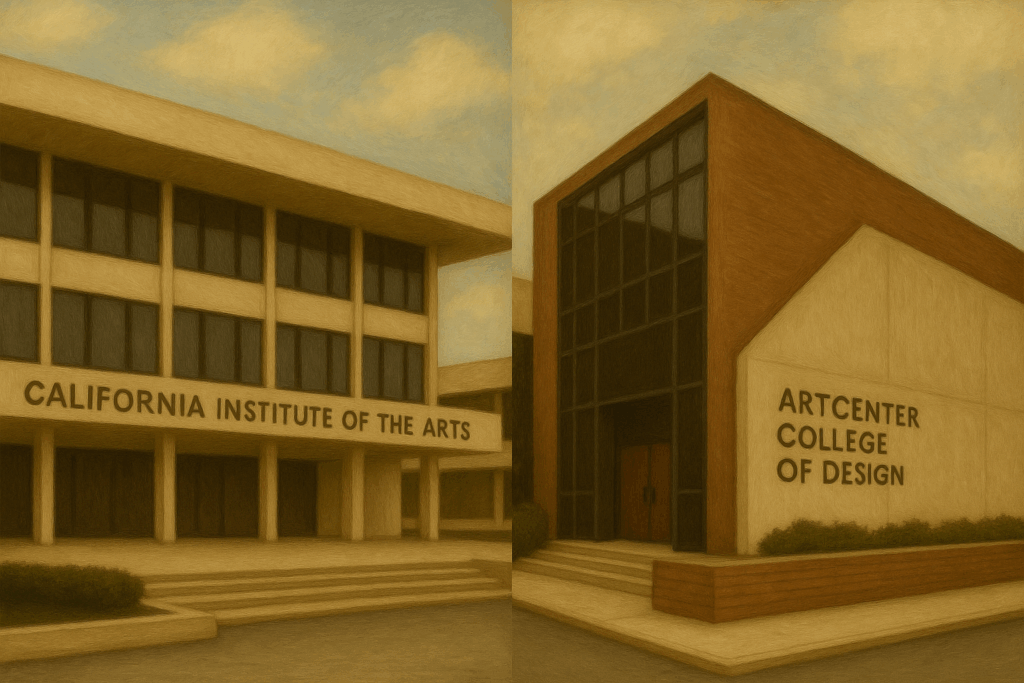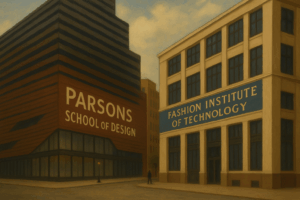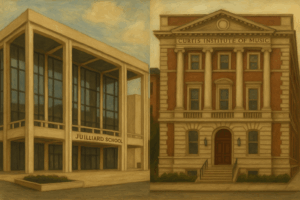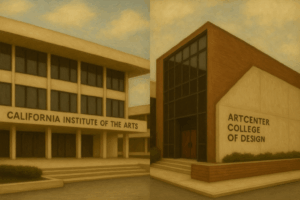
The GOAT of West Coast Art Schools?
As a future artist, designer, and creator, you stand at a critical crossroads. The decision between two institutions that offer world-class arts education, the California Institute of the Arts (CalArts) and ArtCenter College of Design, is more than just choosing a school; it is a crucial process of defining your artistic identity and future direction.
While both schools share the accolade of being ‘the best,’ they offer completely different answers to the fundamental question: “What is the purpose of an artist?” This article, based on the latest 2025 information, will deeply dissect the founding DNA, educational philosophies, curriculum structures, campus cultures, and the legacies of the legendary alumni who represent each school. Are you a ‘Maker’ who wants to achieve mastery through systematic instruction? Or are you an ‘Explorer’ who wants to create new artistic languages without defined boundaries? The process of finding the answer to this question will be the journey to choosing the best school for you.
1. Founding Philosophies: Disney’s ‘Community of Artists’ vs. ‘Professional Education’ for Industry Leaders
CalArts: Walt Disney’s Experimental Utopia
The founding of CalArts was the realization of an artistic utopia dreamed up by a single visionary: Walt Disney.
- His vision was to create a ‘community of artists’ where animators, dancers, musicians, filmmakers, and artists from all disciplines could inspire and receive inspiration from one another under one roof to create new forms of art.
- This suggests that CalArts was designed not as a training ground for commercial success, but as a sanctuary for pure artistic exploration and experimentation.
ArtCenter: The Pragmatic Vision of ‘Tink’ Adams
The goal of ArtCenter’s founder, Edward “Tink” Adams, was clear.
- It was to teach artists and designers the ‘real-world skills’ needed to cultivate them into ‘leaders’ in the fields of advertising, publishing, and industrial design.
- To achieve this, he broke down the walls between the classroom and the industry by composing the faculty entirely of ‘working professionals.’
2. Educational Methods and Culture: Artistic Freedom vs. Professional Perfection
The CalArts Way: Interdisciplinary Fusion and Creative Autonomy
The school’s educational philosophy, known as ‘The CalArts Way,’ is based on student-centered autonomy. It encourages independent artistic activities over a set curriculum, and faculty and students form mentor-mentee relationships as fellow artists. One of its most distinctive features is the policy that students own the copyright to the work they create.
The ArtCenter Way: Industry Partnership and Practice-Oriented Excellence
ArtCenter provides an intensely rigorous and practice-oriented education based on the philosophy of ‘learn by doing.’
- Sponsored Projects: World-renowned companies like Adidas and Uber present real design challenges, and students work in teams to present solutions.
- DesignStorms: Ultra-intensive, 3-day workshops where students experience the rights and responsibilities of a professional designer by being compensated for their intellectual property.
- Designmatters: Teaches the social responsibility of art by conducting projects that solve social problems in collaboration with organizations like the UN.
3. An In-Depth Look at Curricula: Where Does Your Major Fit?
CalArts: The Organic Connection of a Six-School System
CalArts is composed of six schools—Art, Critical Studies, Dance, Film/Video, Music, and Theater—but their boundaries are very flexible. The animation program, which is world-class, is particularly notable for having two completely different BFA programs.
- Character Animation: A systematic program for nurturing talent for mainstream industries like Disney and Pixar.
- Experimental Animation: An open-ended program that approaches animation as a form of fine art, allowing students to explore their own unique aesthetic visions.
ArtCenter: The Depth of a Specialized Departmental System
ArtCenter operates on a system centered around clearly defined departments. The Entertainment Design department, in particular, offers three specialized tracks for the Hollywood and gaming industries.
- Concept Design Track: Visually conceptualizes the worlds, characters, and backgrounds of films or games.
- Animation Track: Teaches the 2D and 3D animation production techniques used in films, commercials, and more.
- Game Design Track: Nurtures professional designers who cover the entire process of game development.
4. An In-Depth Comparison of Alumni: The Artists Who Became Legends
A Clash of Visions: A Unique Worldview vs. Overwhelming Visuals
- Tim Burton (CalArts)
His films are a genre unto themselves. The bizarre yet lyrical gothic style and the affection for ‘outsider’ characters are a perfect expression of the original and personal artistic world that CalArts encourages. - Zack Snyder (ArtCenter)
He is called a ‘visualist.’ His films boast an overwhelming visual style represented by elaborate, painting-like compositions, intense color contrasts, and iconic slow motion. This is a direct result of the technically perfect visual training at ArtCenter. - Analysis:
Tim Burton is an auteur who brings ‘his own world’ to the screen, while Zack Snyder is a visual architect who constructs ‘the perfect world for the story’ on screen.
Two Giants of Storytelling: The Creator of Emotion vs. The Pioneer of Commerce
- Brenda Chapman & Pete Docter (CalArts)
These are the figures who proved the power of story from the heart of Disney and Pixar. The success of Chapman (Brave) and Docter (Up, Inside Out) is deeply rooted in the CalArts educational philosophy that emphasizes character interiority and narrative. - Michael Bay (ArtCenter)
He is the ‘king of the blockbuster.’ He stimulates the audience’s adrenaline with fast, sensational editing, large-scale action, and explosive visual effects. His style embodies the optimal formula for commercial success. - Analysis:
CalArts alumni are magicians of emotion who make the audience ‘laugh and cry,’ while ArtCenter alumni are masters of spectacle who make the audience ‘watch in awe.’
The Future of Design: The Dreamer vs. The Innovator
- Henry Selick (CalArts)
The master who elevated stop-motion animation to an art form with The Nightmare Before Christmas and Coraline. The Experimental Animation program at CalArts provided the fertile ground for him to adhere to his own artistic vision without compromising with the mainstream. - Syd Mead (ArtCenter)
The ‘artist who draws the future.’ He defined the visuals of future worlds through films like Blade Runner and Tron. Based on his experience majoring in industrial design at ArtCenter, he designed functionally persuasive and realistic futures. - Analysis:
Henry Selick is a dreamer who crafts a ‘world that doesn’t exist in reality’ with his hands, while Syd Mead is an innovator who logically designs a ‘future that will soon become reality.’
Icons of Style: Original Style vs. Symbolic Imagery
- Genndy Tartakovsky (CalArts)
The creator of Dexter’s Laboratory and Samurai Jack. He has built his own unique style with an extremely stylized art form and dynamic action direction. - Drew Struzan (ArtCenter)
The legendary illustrator who drew the posters for timeless films like Star Wars and Indiana Jones. He created symbolic images for films that were realistic yet romantically idealized. - Analysis:
For Tartakovsky, the ‘style’ itself is the core of the work, while Struzan’s ‘style’ serves to package the work most attractively and imprint it on the public consciousness.
Creators Who Cross Genres
- Sofia Coppola (CalArts)
A film director. Based on her deep knowledge of fashion and photography, she has built a body of work distinguished by its delicate and sensual visual beauty. - Mike Shinoda (ArtCenter)
A member of the world-famous rock band Linkin Park. He majored in illustration and was in charge of not only music production but also album cover design and visual directing. - Analysis:
Sofia Coppola’s various talents converge for a single, personal artistic vision called ‘film.’ Mike Shinoda’s talents are displayed in parallel across several professional fields like music and design to build a massive commercial brand.
5. Campus and Facilities: Spaces That Nurture Creativity
CalArts: One Giant Creative Laboratory
The Valencia campus of CalArts is designed for ‘interaction.’ All six schools are housed together in a single, massive building, inducing creative inspiration through unintentional encounters and spontaneous collaborations.
ArtCenter: Two Specialized Hubs Separated by Purpose
ArtCenter operates two different campuses in Pasadena.
- Hillside Campus: A modernist structure nestled in the woods, where aesthetics-focused education such as fine arts and graphic design takes place.
- South Campus: A complex converted from former industrial facilities, symbolizing industrial and technology-focused education, including transportation design and AR/VR labs.
Final Conclusion: Which is the Best Art School for You?
A Side-by-Side Core Comparison of CalArts vs. ArtCenter
| Feature | CalArts | ArtCenter |
|---|---|---|
| Core Philosophy | A community of artists, experimentation, self-discovery. | Nurturing professional leaders, practice-oriented training. |
| Curriculum Structure | Flexible, non-linear, interdisciplinary system. | Specialized, department-focused system. |
| Campus & Environment | Integrated mega-building in Valencia. | Dual, specialized campuses in Pasadena. |
| Key Strengths | Animation, experimental art, creative autonomy. | Transportation/Entertainment Design, industry connections. |
| Ideal Student | The ‘Explorer’ seeking their own voice. | The ‘Master’ who wants to lead the industry. |
When You Should Choose CalArts
If you want to find your own voice rather than follow a set path, experiment across the boundaries of multiple fields, and create new art by challenging existing conventions, CalArts might be more suitable for you. Here, you will gain the ‘freedom to become anything.’
When You Should Choose ArtCenter
If you have a clear goal of becoming a top leader in a specific professional field and want to acquire the highest level of technical skill, rigorous training, and a deep understanding of the industry to achieve it, ArtCenter could be the better choice. Here, you will learn ‘how to become the best.’
Now, the choice is yours. The school that will be the most perfect starting point for your artistic journey is surely one of these two.


